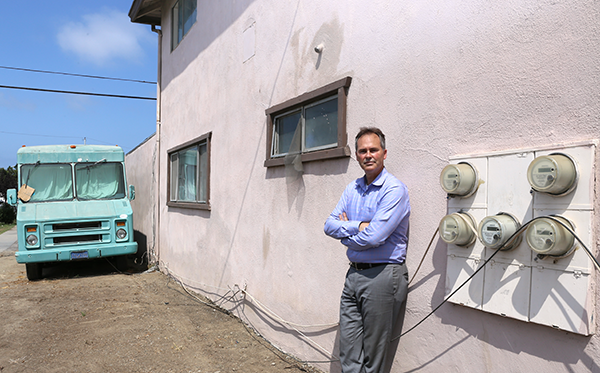
Aug. 1, 2018 - The green revolution that is sweeping California has skipped past the Oak View neighborhood in Huntington Beach. UC Irvine’s Advanced Power and Energy Program wants to help change that and, in the process, conduct some important research. That’s why Jack Brouwer, APEP associate director, and a team of collaborators picked Oak View as the site of its $15 million plan to build an advanced energy community.
The team includes the city of Huntington Beach, the National Renewable Energy Laboratory and Altura Associates, Inc., a company focused on efficient and green buildings.
The effort started 18 months ago, funded by $1.9 million from the California Energy Commission, Southern California Edison and Southern California Gas. Brouwer’s team also partners with residents, community groups and Oak View Elementary School.
Together, they will replace appliances with energy-efficient models, install smart power strips, weatherize homes, blanket the neighborhood with solar panels, add battery electric storage and replace lightbulbs with LED lights.
Additionally, the project will investigate the capability of storing wind- and solar-generated energy with power-to-gas technology. This means surplus energy from solar panels or wind farms is converted into hydrogen, which can be blended with natural gas and used to power home appliances and hydrogen fuel cell vehicles. The surplus energy also can be converted to methane for use in a natural gas pipeline or storage system.
This process can enable the long-term storage of large amounts of carbon-free power. UCI has demonstrated the success of the conversion technology, but injection into the natural gas pipeline system is still in its infancy. The project will contribute to advancing this injection capability.
“Energy storage is critical to increasing the use of renewable energy,” says Yuri Freedman, senior director of business development at SoCalGas. “This project is an excellent opportunity to demonstrate power-to-gas as a storage technology that can directly benefit our customers.”
But first, the Advanced Energy Community project wants to bring more immediate changes to Oak View. Brouwer describes the whirring of air conditioners and hum of power lines crisscrossing the neighborhood.
“Right now, this neighborhood is consuming millions of dollars of power it doesn’t need, and it’s costing residents money they could use to improve their lives.
“We have all the technology to change that, to benefit them and our community – solar panels, fuel cells, low-energy appliances, heat conversion tools, electric vehicles and batteries – but they’re too poor to take advantage of them,” Brouwer says.
Take, for example, the LED lightbulb.
More efficient than traditional lightbulbs and less expensive over time, LEDs are unlikely purchases for residents in Oak View, a tightly packed neighborhood of 10,000 residents in a mix of single-family houses and apartments wedged into one square mile.
Seventy percent of residents age 25 or older lack high school diplomas or equivalency degrees; more than half of those over 16 are unemployed. The per capita income of $16,700 is almost half the county average.
“Residents simply can’t afford to replace a working bulb – even when the new one is more efficient, cost-saving and environmentally friendly,” Brouwer says.
Rolled out over three years, the plan would reduce the community’s energy needs by 25 percent and pay off the $15 million cost in 11 years. (Some elements, like solar panels and LED bulbs, would recoup their cost in just a couple of years.)
To fund the effort, the team is applying for a $10 million grant from the California Energy Commission and seeking $5 million in matching funds from public and private partners.
But changing the physical elements isn’t enough. In order to sustain the program, residents must engage, and community perceptions of green technology must evolve.
The team is connecting residents with jobs in green industries, educational opportunities and the childcare needed to allow time for classes. A booklet guiding residents to resources is in the works. Next, the team will hold workshops with residents to discuss workforce development options.
The group also partners with community groups to provide weekly science, technology, engineering and math (STEM) classes for children at the small library shared by the school and neighborhood. Classes include experiments with solar-powered ovens and photo-sensitive paper.
“When the children are excited, they share that excitement with their parents, who then want to know more about these green options,” Brouwer says.
Oak View ComUNIDAD, a community support group, is excited about the project’s potential, but members are also concerned the changes could price renters out of their homes, according to co-founder Oscar Rodriguez.
“We want to be sure our neighborhood keeps its character,” Rodriguez says. “We suggested they work directly with housing nonprofits that operate in Oak View.”
Rodriguez, who also works for the Orange County Community Housing Corp., says Brouwer’s team listened to their concerns and reached out to the area’s housing nonprofits to see how they could collaborate.
The project will do more than save energy, though.
Lowering harmful emissions means residents will be healthier, reducing impacts on health services. Less greenhouse gas will float into other communities, creating a ripple of benefits. Financial savings and new jobs will bring benefits to cash-strapped families, Brouwer says.
“This project offers a terrific blend of community benefit and research understanding,” he adds. “It’s exactly why so many of us got into academia in the first place – to make a difference that matters.”
- William Diepenbrock / UCI
